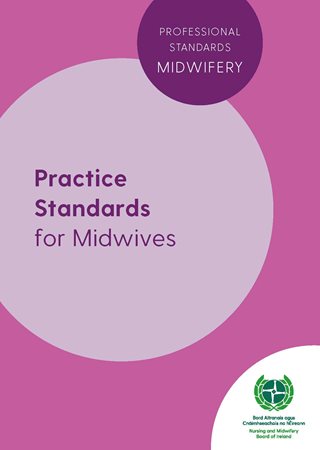Definition and Scope of Midwifery Practice
Definition of a midwife
The Practice Standards for Midwives works with the following definition of a midwife adapted from the International Confederation of Midwives’ (ICM 2017) definition and adopted by NMBI.
A midwife is a person who has successfully completed a midwifery education programme that is based on the ICM Essential Competencies for basic Midwifery Practice and the framework of ICM Global Standards for Midwifery Education and is recognised in the country where it is located; who has acquired the requisite
qualifications to be registered and/or legally licensed to practise midwifery and use the title ‘midwife’; and who demonstrates competency in the practice of midwifery.
Scope of midwifery practice
The scope of midwifery practice is the expected range of roles, functions, responsibilities and activities that a midwife registered with the NMBI is educated for and is competent and authorised to perform. More specifically, the scope of midwifery practice is identified in the EC Directive of 2005 (2005/36/EC).
Article 42 of the Directive states that:
“The Member State shall ensure that midwives are able to gain access to and pursue at least the following activities:
a) provide sound family planning information and advice;
b) diagnose and monitor normal pregnancies; carrying out the normal examinations necessary for the monitoring of the development of normal pregnancies;
c) prescribe or advise on necessary examinations for the earliest possible diagnosis of pregnancies at risk;
d) provide parenthood preparation programmes and provide preparation for childbirth advice including advice on hygiene and nutrition;
e) care for and help the mother during labour and monitor the condition of the baby in the womb using appropriate clinical and technical means;
f) conduct spontaneous deliveries; including where required episiotomies and in urgent cases breech deliveries; recognise the warning signs of abnormality in the mother or baby’s condition which need to be referred to a doctor and assisting the doctor if necessary. The midwife should also take the necessary emergency measures in the doctor’s absence, in particular the manual removal of the placenta, possibly followed by manual examination of the womb;
g) examine and care for the newborn infant and take all initiatives that are needed, including resuscitation if necessary;
h) care for and monitor the progress of the mother in the post-natal period and advise her on infant care so that the baby makes the best possible progress;
i) carry out the treatment prescribed by doctors;
j) draw up the necessary written reports.”
If a midwife wishes to expand their practice, or if they are being asked to expand their practice, they should refer to the Scope of Nursing and Midwifery Practice Framework (NMBI 2015) and work through the decision-making framework. Nothing in this or any other document should be construed as prohibiting a midwife from expanding their practice in relation to any practice or procedure provided the midwife has ascertained, by working through the decision-making framework, that it is appropriate to do so.
An individual midwife’s scope of practice is dynamic – that is, it will change and grow as they progress in their career.
The scope of practice of the individual midwife is influenced by a number of factors including:
- the practice setting;
- local guidelines, polices and evidence base;
- the midwife’s educational preparation, experience and competence;
- collaborative practice; and
- other factors, such as the woman and baby’s safety, their needs and care outcomes.

Practice Standards for Midwives
.pdf Download (789KB)
Download